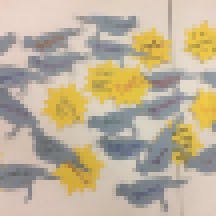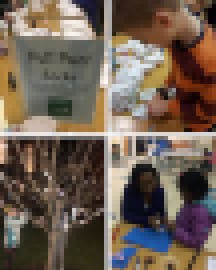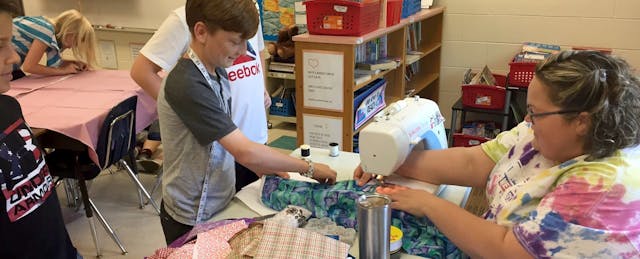Last April, the entire faculty at Bettie Weaver Elementary School spent an afternoon making rice heating pads for local elderly residents, capes for foster children to help endure long hospital stays and jump ropes braided out of plastic bags that were later given to schools in Haiti by three of our teachers. We spent three hours working together toward a common goal: serving others.
On this county-wide professional development day, while teachers at many schools around Chesterfield watched the clock, thinking about papers that needed to be graded and plans that needed to be written, the staff at Weaver Elementary spent the day immersed in service and learning together. Concerns about how to manage to-do lists faded and compliance was no longer the reason for showing up. Teachers were engaged with one another and felt empowered to make a difference.

Image Credit: Weaver Elementary School
When three hours had passed, we had a hard time getting the staff to leave. As an exit ticket, teachers filled out a one-word reflection on the day. “Uplifting,” “rewarding,” “inspiring” and “joyful” are not typically words you hear after a 3-hour PD session. That’s when we realized what we had learned at the service-learning conference we’d attended just a month earlier could make change in our community.
As we glanced around the room at stations filled with piles of heating pads, capes and jump ropes, we knew something special had happened. We wondered if the power of serving others could bring our school from good to great and from compliant to engaged.
A New Priority
Weaver Elementary, located outside Richmond, VA, in Chesterfield County, is named after long-time Chesterfield educator and historian, Mrs. Bettie Weaver. She was committed to authentic learning and connecting to the community and the environment. With a devotion to embracing the ideals of its namesake, our school has had a history of academic excellence through community relationships and involvement.
In fall of 2016, when Chesterfield County Public Schools began reworking its strategic plans, the district challenged principals to “imagine tomorrow,” rethink what a school experience should be and determine what each school stood for.
Our transition to project-based learning environments in 2013 allowed us to elevate student voice and choice and when students reflected on which projects resonated most, we learned that they cared most deeply about projects involving service toward others. Recognizing the profound effect of that work, we determined that a commitment to service-learning would be a key component to continuing our success.
Getting Schooled
At the beginning of our quest to reimagine our school, we thought of service-learning as a curricular approach in which students use academic knowledge and skills to address community needs. But as we later learned, curriculum was only one piece of the puzzle; if we wanted to prioritize service-learning, we’d need to connect with our community, get buy-in and take action.
After attending the National Service-Learning Conference in March 2017, which was sponsored by the National Youth Leadership Council (NYLC), we realized there was much more to service-learning than we initially thought. NYLC defines it perfectly through example:
“Picking up trash on a river bank is service. Studying water samples under a microscope is learning. When science students collect and analyze water samples, document their results, and present findings to a local pollution control agency—that is service-learning.”
Leading by example, conference facilitators actively engaged participants in service-learning experiences. While picking up trash on a local beach with peers from around the globe, it became clear that we had misperceived its reach. This kind of learning is happening in schools and youth programs all over the world and many of the people leading this work are purposefully connecting it to the United Nations Global Goals for Sustainable Development, a set of 17 goals to make the world a better place by 2030.

From “Feel Good” Moments to Deeper Learning
We left the conference inspired. It feels good to pick up trash on a beach and leave an environment better than you found it. But when we got home, we immediately recognized that it can’t just be a “feel good” program—it’s about more than that.
We needed to find a way to convey what we had learned to our colleagues who didn’t attend the conference. Some would be all-in after hearing about it, but others would need to see it to believe it. That's why our first step upon returning home was to design the afternoon of service for our teachers as an alternative to our traditional PD day.
Our next step was to hook our families, so we revamped our “school-wide family read,” which was traditionally a month-long event where every family read the same book. Historically, the month culminated in an evening of celebration and connection to each other, where families would come to school, work on craft activities and engage in conversations about the book.
This time we changed it up, using the experience as a tool to help families understand the value of service-learning through participation. With themes of friendship, tolerance and kindness, “Wishtree,” by Katherine Applegate was the perfect book to build a night of service for our families.
Instead of setting up stations where students could create bookmarks for themselves or make snacks related to the book, we designed stations where families could work together to make non-slip socks for hospital patients and fleece hats for people undergoing cancer treatment, sort food for the local food pantry and tie wishes for the world onto one of the trees outside of our school. Most of the stations were aligned to the Global Goals to bring an added awareness of the impact families were having beyond our walls.

Go Big or Go Home Doesn’t Really Apply Here
No poverty, zero hunger, and clean water and sanitation are lofty goals that will likely not be resolved by one person or one solution. All 17 of the Global Goals are big and that can make us feel powerless if we let it, but part of the work is recognizing and honoring that small ripples can make big waves.
Time is not always on our side and large scale projects aren’t always feasible, but it doesn’t have to be about carving out time for “something else.” Considering ways to incorporate the tenets of Global Goals and service-learning into what is already taking place in the classroom can be equally impactful.
Is your class in the middle of a persuasive writing unit? Perhaps students can write to a school board official suggesting how to improve accessibility for all children on the playground. When researching and making models of the food chain, can the class discuss food deserts and why some people around the world do not have access to fresh food or water? Instead of measuring classroom furniture, could students practice measurement skills while sewing backpacks for students in need?
Incorporating service-learning into your practice is not a call to abandon traditional curriculum—it’s being conscious about the goals and looking for opportunities to work toward one.
Aligning projects to state or district standards and priorities is a necessity for many educators and there are supportive resources made available by organizations that have already done some of the heavy lifting for teachers. NYLC developed a series of K-12 Service-Learning Standards for Quality Practice with curricular modules that bring them to life. Using these standards as a framework for designing service-learning experiences is integral to creating meaningful growth far beyond test scores.
As for projects, Learning to Give has a bank of searchable lessons aligned to state standards and The Generator School Network, an online community of youth and adult members engaging in service-learning, built the Generator, a tool to help teachers plan service-learning projects.
We believe our world needs more humans who naturally gravitate toward taking actions that help others. That’s why our team is making it a priority to model how the little actions we take today can become part of who we are tomorrow. Google’s Global Education Evangelist Jaime Casap challenges us with these words: “Don't ask kids what they want to be when they grow up but what problems do they want to solve.” We believe this change in the conversation is critical, and service-learning is helping us make the shift with our students.


